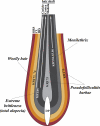To grow or not to grow: hair morphogenesis and human genetic hair disorders
- PMID: 24361867
- PMCID: PMC3988237
- DOI: 10.1016/j.semcdb.2013.12.006
To grow or not to grow: hair morphogenesis and human genetic hair disorders
Abstract
Mouse models have greatly helped in elucidating the molecular mechanisms involved in hair formation and regeneration. Recent publications have reviewed the genes involved in mouse hair development based on the phenotype of transgenic, knockout and mutant animal models. While much of this information has been instrumental in determining molecular aspects of human hair development and cycling, mice exhibit a specific pattern of hair morphogenesis and hair distribution throughout the body that cannot be directly correlated to human hair. In this mini-review, we discuss specific aspects of human hair follicle development and present an up-to-date summary of human genetic disorders associated with abnormalities in hair follicle morphogenesis, structure or regeneration.
Keywords: Alopecia; Genetic disorders; Hair follicle; Morphogenesis; Shaft differentiation.
Published by Elsevier Ltd.
Figures



References
-
- Ohyama M, Vogel JC, Amagai M. Gene ontology analysis of human hair follicle bulge molecular signature. J Dermatol Sci. 2007;45:147–50. - PubMed
-
- Cotsarelis G. Epithelial stem cells: a folliculocentric view. J Invest Dermatol. 2006;126:1459–68. - PubMed
-
- Jaks V, Kasper M, Toftgard R. The hair follicle – a stem cell zoo. Exp Cell Res. 2010;316:1422–8. - PubMed
Publication types
MeSH terms
Grants and funding
LinkOut - more resources
Full Text Sources
Other Literature Sources
Medical

